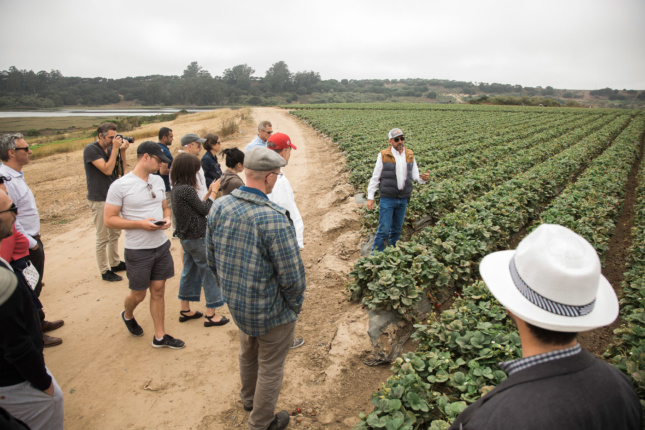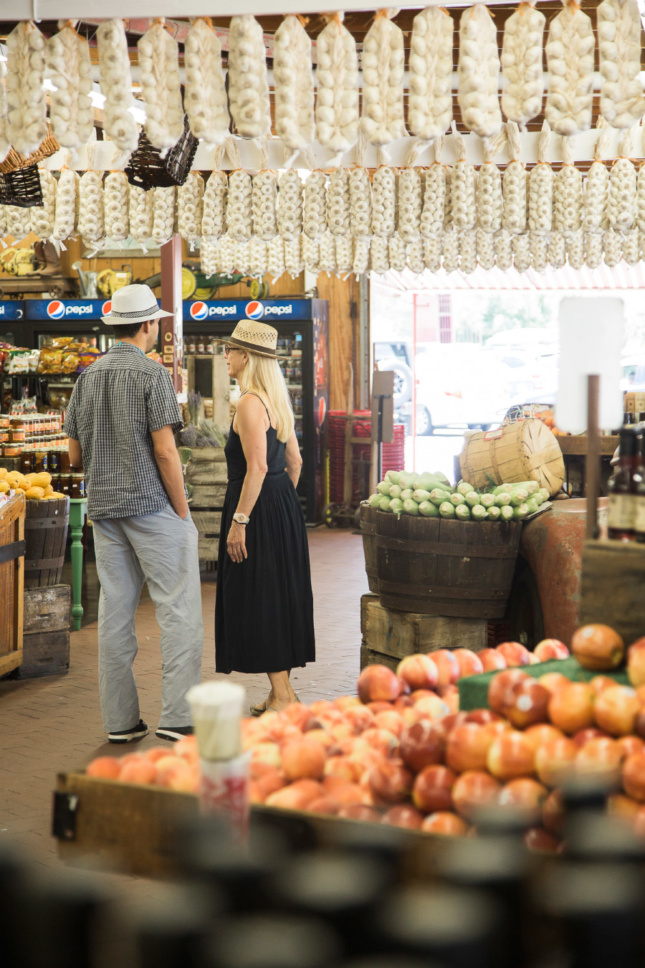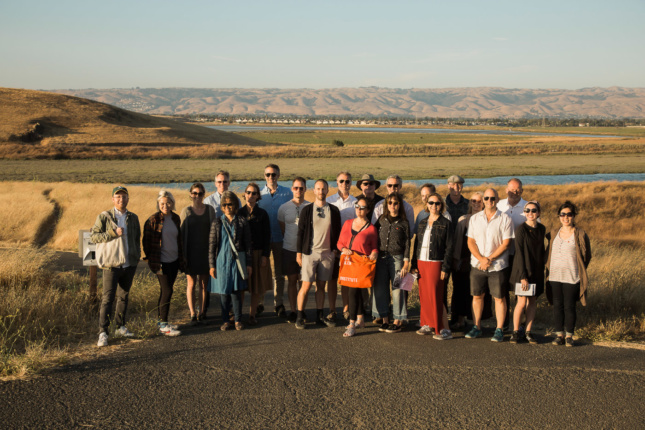The hot July sun hit the grooves of the farmland barreling past our bus windows as we approached Bowles Farming Company in Los Banos, California. Envisioning sunburns and muddy hikes through the furrows, we—the two dozen landscape design, engineering, and architecture professionals that make up the Van Alen Institute Climate Council—were about to visit the farm as part of a three-day expedition in Northern California to consider how design thinking could impact the way this farm and farms like it plan for climate change.
Van Alen launched the Climate Council in 2018 as a platform for practicing design professionals and climate change aficionados to convene for twice-annual, three-day expeditions in regions across the U.S. Through tours, discussions, social gatherings, and hands-on charrettes, our trips provide members with a congenial setting for learning and reflection away from the hectic pace of everyday business.
Right at the beginning of this inaugural trip, the Climate Council’s expectations contrasted dramatically with the realities of modern agriculture. Instead of weathering watermelon fields, we found ourselves in a comfortable boardroom. Farm executives welcomed us with cut melon samples and a PowerPoint presentation of the farm’s history, challenges, and technology. Over the soft hum of air-conditioning and with his adolescent son beside him, Cannon Michael, the farm’s president and CEO, shared the impressive facts of his large-scale operation: 11,000 acres, 14 crops, and six generations.
Bowles has an advantage that it shares with a small group of farms in the area: Their history of utilizing water from the San Joaquin River provides senior rights to surface water. But with that seniority comes an increased responsibility and stewardship. Their on-staff agronomist schedules crop irrigation daily with care for every drop, logging and adapting to changes in climate on the spot.
Michael proudly told us of the precision and care that Bowles uses to manage its water supply amid California’s mounting water crisis. “In times of drought, farmers are often blamed for overusing water,” Michael said. “The reality is, it’s not in a farmer’s best interest to waste water, as we only want to use the exact amount that the crop needs—improper water management has a negative impact on crop production. California is an expensive place to do business, and we must carefully monitor all our inputs and costs, water being a primary one of them. It is also a fact that producing the food and fiber we all rely on every day takes water. Where these products are produced is of critical importance. Not all farms are held to high standards of environmental and ethical production—California leads the way in the world.”
Bowles’s commitment to precision and innovation unraveled the Climate Council’s anticipated mission and sent us on a new track of questioning in the days that followed. After visits with a strawberry farmer, a food distribution company, a tomato processing plant, and more, we started asking: What if cities had intricate systems dedicated to tracking inputs and outputs as accurately as these farms?
We had set out on our trip thinking we would consider how design could impact the future of food production and distribution, but instead, we realized that cities had at least as much to learn from modern agricultural practices.

Van Alen Climate Council
Twice a year, the Climate Council travels to the same region—the first visit for exploration, the second for strategizing and discussing pressing climate issues using an interdisciplinary, systems-based approach. We offer professional advice to our partners and hosts, and aim to share lessons learned with other regions, both through further council travel and via members’ professional practices. The council’s purpose is rooted in Van Alen’s mission as a design organization that seeks to understand and demonstrate how design can transform cities, landscapes, and regions to improve people’s lives.
The council also provides support and funding for Van Alen’s broader climate-related work. For more than a decade, we have created cross-disciplinary design and research projects that investigate issues of climate change across the country, from the sinking Lower Mississippi River Delta to the hurricane-battered eastern coasts. We are presently working in Greater Miami to help communities protect themselves from rising sea levels, using a design approach to make the region more socially equitable and economically resilient.
In selecting the inaugural topic for the Climate Council to explore, co-chairs Claire Weisz and Mark Johnson commented, “We wanted to look at food as the first subject with this council. It’s all-encompassing. It’s something designers don’t get to talk about very often but that ultimately impacts us.”
Even designers who work in cities have a vested interest in learning more about the role of agriculture in our society. At a panel conversation during our program, Mary Kimball, the director for the University of California, Davis’s Center for Land-Based Learning (and a partner in developing the council’s California program), reminded us that more than two-thirds of Sacramento’s regional farmland specialty crop jobs are in urban environments. Even though we typically associate agricultural jobs with rural labor, food distribution and packaging centers require resources that are almost always located in urban environments. So much of the food economy surrounds people in urban spaces every day, but we just don’t see it. Similarly, many of the challenges that farmers face in today’s economy are relevant to city dwellers.

Time is of the essence
On our first day in California, council members met David John, the business strategist at General Produce Company, a distribution center located 10 minutes from the central business district of Sacramento. As we walked through dozens of icy storage rooms, John told us that from the time of arrival to the time of departure, almost all of the fresh fruits and vegetables are present in the facility for less than 48 hours. The center runs 24/7, with days off only on Christmas and New Year’s. When asked about the built environment of the facility, John said that many of the workers adjust rooms or shelving as needed with changes in supply, but that it is difficult to allow for changes because they take time away from moving product. This distribution center, like a vital transit system in a big city, cannot take a day off. We surmised that systems thinking, like that used in transportation engineering, could be used to create more flexible environments in food distribution centers, along with more adaptable storage facilities.

The berry farmer’s dilemma
Following a brief meeting with the president of the Strawberry Commission of California near Salinas, our council climbed through coastal strawberry fields owned and operated by Tom AmRhein of Naturipe, Inc. AmRhein presented us with a pressing issue that berry farmers are facing in the area: The median home value in Salinas is more than $400,000. With minimum wage for farm laborers at $11 an hour, an enormous gap exists between the incomes of berry pickers and the supply of affordable housing in the area.
As a result, AmRhein said that as many as five different families may share a home together in the valley, bringing housing density to the level of some of the nation’s biggest cities. As we downloaded our findings from Tom, the council considered what kind of affordable housing solutions could designers, working with migrant communities, dream up for rural laborers and their families. Moreover, with climate change making weather patterns and farming yields more unpredictable than ever, what kind of housing solutions would provide stronger, more stable, and adaptable shelters in this harsh environment?
What’s next?
When asked about innovation in agriculture, our program collaborator Kyeema Zerbe, deputy director of the UC Davis Innovation Institute for Food & Health (IIFH), said, “The IIFH prides itself on making uncommon interdisciplinary connections to catalyze innovation across food, agriculture, and health. Collaborations like those with Van Alen help facilitate exploration of systemic issues and view prevailing challenges from new local and regional perspectives. By delving into the intersections between design, agriculture, and innovation, we can begin to imagine a safer, more sustainable and secure food system.”
Van Alen believes that climate change is an all-encompassing phenomenon. In such politically divided times, the organization seeks opportunities where designers can work under the partisan radar to generate true collaboration between cities and their surrounding regions, inviting professionals from all backgrounds to innovate. The Climate Council’s experience in Sacramento is an example of how nontraditional collaboration and open-mindedness can lead to enlightened discovery. And it’s just the beginning.
On its third day in California, Climate Council members huddled pensively around drafting tables at the UC Davis Department of Landscape Architecture. Over the hours of charrette that followed, they revisited the issues that arose during this trip: How could farm feedback loops inform urban design? What role does governance play in the lack of balance of inputs and outputs in major cities? How can interdisciplinary design professionals enhance the security and resilience of existing rural communities that support our farm industry? Together, we started envisioning answers to these and other questions and made plans to return to Sacramento in early 2019 with design concepts to address them. When we go back, we intend to continue our conversations with local farmers, community members, and other stakeholders. We know there are opportunities for collaboration and implementation; we just need time together. We are onto something.











